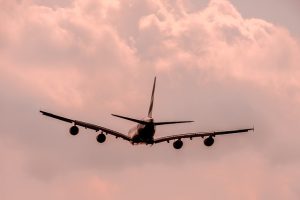
The empennage is an important part of modern-day airplanes. Also known as the tail assembly, it features several flight control surfaces that are primarily used to stabilize the airplane. While most airplanes have a single tail, though, others have two tails.
Single-tail and twin-tail airplanes both feature an empennage, but the latter has two separate tails on the empennage. The adjacent photo shows a single-tail airplane. There’s a single vertical fin on the rear of the airplane. But other airplanes may feature of these vertical fins.
What Is a Single-Tail Airplane?
Single-tail airplanes are exactly what they sound like: airplanes that feature a single tail on the empennage. Tails consist of vertical fins or “stabilizers. The empennage is the entire tail assembly at the rear of an airplane. All airplanes have an empennage, but the number of tails on this empennage may vary.
The empennage on single-tail airplanes has a single tail. Single-tail airplanes are common. Most commercial airliners, as well as private airliners, feature a single-tail empennage
What Is a Twin-Tail Airplane?
A twin-tail airplane is a type of airplane that features two tails on the empennage. They are also known as H-tail airplanes because the empennage resembles the shape of the letter H.
While not as common as single-tail empennages for commercial and private airliners, many military airplanes feature a twin-tail empennage. Twin-tail airplanes, in fact, were particularly common throughout World War II. Many Allied airplanes, including the B-24 and B-25, were classified as twin-tail airplanes.
Differences Between Single-Tail and Twin-Tail Airplanes
Airplanes can be classified as single-tail or twin-tail depending on their number of vertical fins. Vertical fins are found on the empennage. They are designed to stabilize airplanes. Single-tail airplanes feature a single vertical fin in the center of the empennage. Twin-tail airplanes, on the other hand, feature side-by-side vertical fins on the empennage.
Twin-tail airplanes suffer from less parasitic drag than their single-tail counterparts. Manufacturers can design the lower part of the two tails so that they are thicker than the upper part of the two tails. This design allows for less parasitic drag.
Single-tail airplanes are simpler and easier to maintain. This alone is reason enough for many manufacturers to use them. Twin-tail airplanes have a more complex empennage, so they require more work and time to maintain.
In Conclusion
Most airplanes have either one or tails on the empennage. Single-tail airplanes have one tail on the empennage, whereas twin-tail airplanes have two tails on the empennage.



